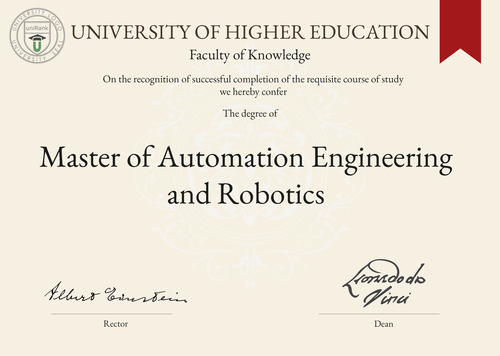
Master of Automation Engineering and Robotics (M.A.E.R.)
Guide to Master of Automation Engineering and Robotics Program/Course/Degree
Master of Automation Engineering and Robotics (M.A.E.R.)

Program Name:
Master of Automation Engineering and RoboticsProgram or Degree abbreviation:
M.A.E.R.Duration range:
Varies by country and university, typically 1-2 yearsTuition range:
Varies by country and university, typically $10,000-$30,000 per yearOverview:
The Master of Automation Engineering and Robotics program is designed to provide students with advanced knowledge and skills in the field of automation engineering and robotics. This program combines theoretical knowledge with practical applications to prepare graduates for careers in industries such as manufacturing, automotive, aerospace and healthcare.Curriculum Overview by year:
- Year 1: - Introduction to Automation Engineering - Robotics Fundamentals - Control Systems - Sensors and Actuators - Industrial Automation - Year 2: - Advanced Robotics - Artificial Intelligence in Automation - Machine Learning for Robotics - Robotic Vision Systems - Automation Project ManagementKey Components:
- Automation Engineering - Robotics - Control Systems - Sensors and Actuators - Industrial Automation - Artificial Intelligence - Machine Learning - Robotic Vision Systems - Project ManagementCareer Prospects:
Graduates of the Master of Automation Engineering and Robotics program can pursue various career paths, including: - Automation Engineer - Robotics Engineer - Control Systems Engineer - Industrial Automation Specialist - Research Scientist - Project ManagerSalary Expectations:
Salaries for professionals with a Master of Automation Engineering and Robotics degree can vary depending on factors such as location, industry and experience. On average, graduates can expect a salary range of $60,000-$100,000 per year. For a more accurate understanding of salary expectations, you can utilize the Job Sites Search Engine, from our sister site jobRank, which searches over 4,600 job sites worldwide. Make sure to specify not only the job title but also the country you are interested in.Conclusions:
It is important to note that the duration, tuition fees, curriculum, key components, career prospects and salary expectations of the Master of Automation Engineering and Robotics program can vary depending on the chosen country or location of study, as well as the chosen university. Prospective students are advised to research and compare different programs and universities to find the best fit for their needs and goals. Visitors interested in pursuing a Master of Automation Engineering and Robotics degree can use the uniRank World Universities Search Engine to find universities offering this specific degree anywhere in the world. This search engine provides comprehensive information on universities, programs and admission requirements, helping students make informed decisions about their education.World Universities Search Engine
search for Master of Automation Engineering and Robotics (M.A.E.R.) and add the Location (country, state etc.) or specific University you are interested in studying at.
Query examples:
- Master of Automation Engineering and Robotics (M.A.E.R.) United States
- Master of Automation Engineering and Robotics (M.A.E.R.) United Kingdom online
- Master of Automation Engineering and Robotics (M.A.E.R.) Australia international students
- Master of Automation Engineering and Robotics (M.A.E.R.) University of California
- Master of Automation Engineering and Robotics (M.A.E.R.) University of London tuition fees
- Master of Automation Engineering and Robotics (M.A.E.R.) University of Sydney scholarships
Share Program/Course
Interesting? Share this program/course/degree info with your friends now.